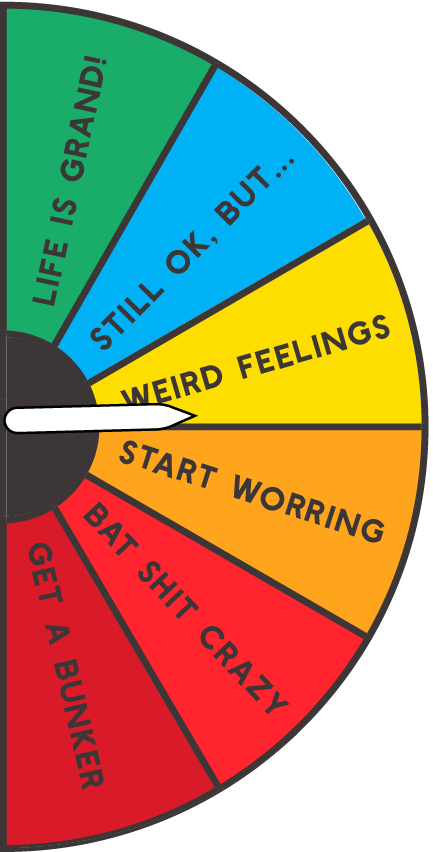Volcanoes are erupting in The Philippines, but on-fire Australia received some welcome rain. The Iran war cries have been called off and The Donald’s military powers are about to be hamstrung by the Senate. Meanwhile, his impeachment trial is starting, and we’re all on Twitter for a front-row seat.
Are we as sure about the future as we think we are?
An argument for a new kind of optimism

The great philosopher Karl Popper said that the possibilities that lie in the future are infinite. He went on to say that because all of us have a responsibility to construct that future, we have a responsibility not to prophesy evil, but to work for a better world.
Now, if we read the headlines, it’s clear to us that we are living in the soup of dystopia. We are in a culture that is characterized more by Armageddon, by doom and gloom than it is characterized by hope and faith in the endless possibility of the future. This is a profound cultural moment, particularly in the West, that is in stark contrast to other cultural moments where the opposite would have been true.
If you had read the covers of TIME magazine 20 years ago, you would have been greeted with a panoply of presentations about the endless possibilities that the future held: the magical convergence of technology and the stock markets, the end of the Cold War, the triumph of liberal democracy, and the opening arc of freedom around the world that were all going to lead to a transformative 21st century. It was much the way the culture in the 1950s felt about the end of the 20th century. Whether that was going to mean atomic-powered cars or people living on the moon, there was a perception that the future held an opening arc of human potential that would likely be realized. You can go back throughout the past several hundred years and find that this view has repeated, and that at each time it did, that notion of progress and of the endless possibility of the future was potent and powerful.
We are not in one of those moments. Now, we are in a moment of deep pessimism about the future. You can read polls about this. Pew does surveys every year about public attitudes about whether or not the world will be better for your children. In the Western world and in developed economies between 60–70% of people believe that the future will be worse and many believe that it will be significantly worse. So the question is not whether we should all be more optimistic. It is what it means to be optimistic in a time of deep pessimism.
Optimism has hugely negative connotations today. It is seen as naive. It is lambasted just as Voltaire lambasted the Panglossian view that we live in the best of all possible words, which is a whole school of thought that we have created the best of all possible worlds and that that will continue. It’s easy to say that the evidence speaks profoundly to the contrary. It doesn’t take much to see the ways in which the world around us has and is beset by manifold problems. So if optimism means that we’re supposed to ignore the evidence that those problems exist, then optimism is in fact foolish.
But there’s another way to look at optimism. The theoretical physicist David Deutsch described optimism not as that Panglossian “we live in the best of all possible worlds,” but as the humility of Popper’s initial statement, which is that the world ahead of us is inherently unknown. Its possibilities are infinite. Therefore, the belief of certain doom, the pessimism that says we are all headed for bad things—and that we know this because of the evidence in the present that suggests that’s where we will go in the future—is in and of itself a statement of human arrogance. It is the arrogance of certainty, that future outcomes that we are still in the process of creating are inherently known and certain.
We are in a groove that we can’t get out of. Even suggesting that the future is uncertain and our outcomes have yet to be constructed, about, say, climate change, is treated as an arrogance akin to saying to somebody who has been shot at by a gun that it is uncertain that the bullet is going to hit them and therefore we shouldn’t say that they are about to die.
And yet climate change is not like someone aiming a gun and shooting a bullet at us. Rather, it is at least at two levels a challenge for how we deal with the uncertainty of the future. It is absolutely certain that there is climate change. It is also almost absolutely certain that human activity has not only accelerated it but is accelerating it even more. It is also relatively certain that climate change will create massive disruptions in human society in the decades ahead. What is not certain, and where optimism comes into that equation, is how human beings will adapt to that reality. To conflate those two things—that we know that there is massive climate change, but we don’t know how humans will adapt to that reality—is to fall into that pessimism trap of assuming that we not only know that a challenge exists, but also know exactly how human beings and societies will grapple with that challenge.
In other words, we know absolutely one thing, and we are acting as if we know absolutely the other. This, I think, is true in general about how we are reading the present in light of what we think about the future. There are any number of people now who can point to all the data about the way the world is better than most people believe it to be. Steven Pinker’s recent bestseller Enlightenment Now said that the world as it is now, at every metric that humans have looked at and grappled with since time immemorial, is better. Whether those metrics be longevity of life, access to healthcare, stable societies, or less risk of lethal harm from others, the world, in every place and in every area, is better off than it was.
You would think that such conclusive data would lead to a complementary sentiment. But it does not. To simply quote chapter and verse of longevity of life to a world and cultures that are deeply aware of all the problems we are facing can feel almost infuriating. To say to somebody, look—a townhouse in 1948 was the height of a middle class existence. It was about 800 square feet, with two rooms at the top of the stairs and two rooms at the bottom. It had a kitchen that would not have had a refrigerator, but would maybe have had an icebox. You were lucky if you had a car outside, one that would not have had anti-lock brakes, air conditioning, or seatbelts, but would have had an ashtray. (So it could kill you, and it could kill you.)
But to pick the thread back up, to say to somebody today, look how much more room you have and look at all the pleasures and the accoutrements and the comforts, and therefore you should feel better about the world, can be legitimately insulting, because it assumes that we live in every given moment with full awareness of the full spectrum of how humanity has evolved to this point in time. We don’t. We reset our level of expectations in the present, and then we look to the future and we tend to hope and want and desire that that future be better, not worse.
We are living in a time where there is a widespread perception of that future getting worse. Some of that culturally is Schrodinger’s cat. As Schrodinger famously said, if you look at a cat from one direction, it looks like a cat, but if you turn it in another direction it looks like a rabbit. Which is it, a cat or a rabbit? Another way of seeing the future and the present is as a cup half full or a half empty, and if anybody looks around the world today, those sorts of dichotomies become almost impossible to reconcile with the massive protests that have beset a lot of the developed and developing world, whether it’s people rioting in Chile because of an unfair perception of costs being passed onto them for subways or the crises in Brazil about massive government corruption.
Is that a sign of the decay of democracy or is it a sign of the functionality of democracy? These are questions that are only answered depending on your perspective about where things stand and where they’re going. There’s not an absolute answer to those questions, but we are many of us answering them in the absolute. We are certain that these dots on both a global and national spectrum represent incontrovertible evidence of how everything that was good is decaying and will get worse.
How the future unfolds is in part dependent on how we unfold it.
When I talk about the need for us to think more optimistically, it is not from the belief that I or any of us know with any certainty which of those two realities are going to emerge in the future. It is with the certainty that I and all of us have absolutely no idea which of those realities is going to emerge in the future. And it behooves all of us, keeping Popper’s statement in mind of how the future unfolds is in part dependent on how we unfold it, to consider the possibility that our fears in the present and our perception of dystopian decline is not commensurate with how that future will unfold, and to pay more attention to evidence and analysis to the contrary before we conclude with certainty that the future that’s unfolding is inherently going to be much worse.
There are pragmatic reasons to do this, which are that if we do to some degree construct our future, believing for sure that that future is going to be worse would seem to be an element in making that statement true. Maybe not the only element, but certainly one of them. There’s also some evidence that societies that believe collectively and individually that they are capable of solving their problems—admittedly, problems that they’ve created—are societies that do a better job at solving those problems. And that societies that take a more fatalistic view of the negativity of the future tend to be more passive.
The risks of believing with high levels of certainty that the future will be worse are the risks that we will be overestimating the dangers that lie ahead and underestimating the opportunities in the investing world. This could be as simple as: why isn’t everyone buying bonds when there’s no yield on bonds? They’re doing so because there’s a perception that everything is about to get worse, and getting as much as you can now is better than risking it all later. That’s an inherently pessimistic view of an outcome. It may be absolutely the correct view, but it is a pessimistic one. If that is done in aggregate too much, it means, why would any of us follow a hope or a dream? What’s the point of going to a good school or trying to start something on your own if it’s all going to go to pot? Such a view also includes that this is a zero sum world that’s getting ever tighter. If you don’t get what you can when you can, there will be nothing left. That is not a socially healthy way to solve our issues.
This is what The Progress Network is—an attempt to gather people whose voices and sensibilities are a little more focused on the possibilities and the potential, so they can form a critical mass in a society where those voices are atomized. In a “if it doesn’t bleed, it doesn’t lead” world, voices to the contrary, that suggest things may be getting better, tend to get drowned out by voices that suggest that we are not.
All of this is simply a plea to be more humble about what we think we know about the future, and to acknowledge that our belief in a bad one will absolutely raise the likelihood that that’s where we will end up. We can take a more open and constructive stance toward our ability, over the course of time, to solve and clean up messes that we’ve created.
I’ll end with this observation. If all of human history has been a neck-and-neck race between the incredible capacity of human beings to create and the unbelievable ability of human beings to destroy, we are at least narrowly on the side of the angels, because we are still here having that debate. I would place a certain amount of faith—or a certain amount of open question—that we will be able to make the same statement a hundred years from now that we are able to make today. We need to pay more attention to that possibility, whether or not that is of high probability.
Adapted from a talk originally given at the 2019 Octavian Forum. Watch the video here.


